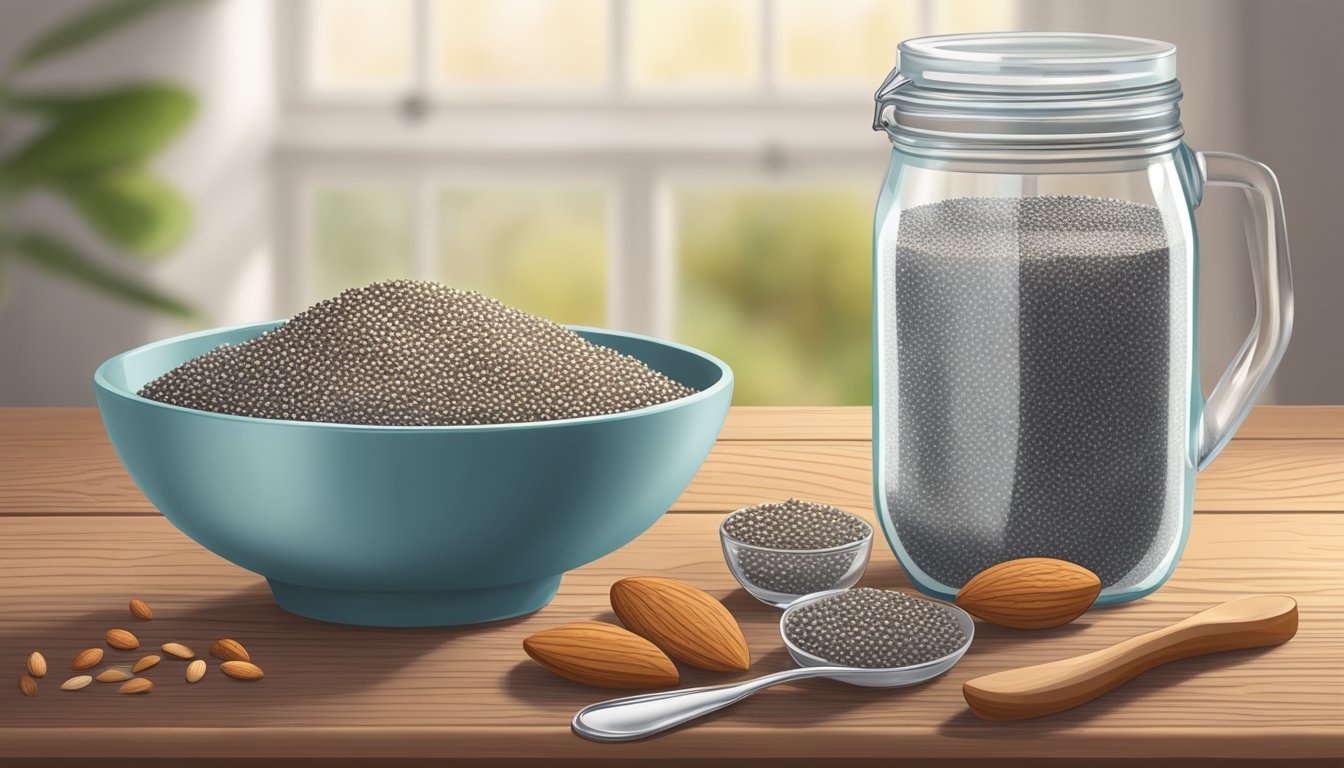4 Best Chia Seed Recipes for People with Diabetes
Delicious and Healthy Options
Chia seeds have gained popularity among health enthusiasts due to their numerous benefits, particularly for individuals managing diabetes. These tiny seeds are rich in fiber, omega-3 fatty acids, and antioxidants, making them an excellent addition to a diabetic-friendly diet. They can help stabilize blood sugar levels and support overall well-being.
For individuals with diabetes, incorporating chia seeds into meals can be a delicious and nutritious way to maintain better blood sugar control. From puddings to smoothies, there are several creative recipes that make it easy to reap the benefits of chia seeds while enjoying flavorful dishes. These versatile seeds can be effortlessly included in various meals, providing taste and health benefits in one package.
1) Chia Pudding with Almond Milk
Chia pudding with almond milk is a simple yet nutritious option for people with diabetes. It combines the benefits of chia seeds, which are high in fiber and omega-3 fatty acids, with the creamy texture of almond milk. This combination helps stabilize blood sugar levels and provides a satisfying, guilt-free treat.
To prepare this pudding, you need chia seeds, almond milk, and a natural sweetener such as honey or maple syrup. In a bowl, mix the chia seeds with almond milk and sweetener until the seeds are evenly distributed. Let the mixture sit for a few minutes, then stir again to prevent clumping.
Refrigerate the mixture for at least 2 hours, or preferably overnight, to allow the seeds to fully absorb the liquid and swell. The result is a thick, pudding-like consistency that is both filling and delicious.
This chia pudding is versatile, allowing for various flavor additions. You can add vanilla extract for a classic taste, or mix in cocoa powder for a chocolate version. Fresh berries, nuts, or a sprinkle of cinnamon can serve as delightful toppings.
2) Chia Seed and Berry Smoothie
The Chia Seed and Berry Smoothie is a nutritious option for those with diabetes. Berries are low in sugar and high in antioxidants, making them a healthy choice. The addition of chia seeds increases the fiber content, which helps regulate blood sugar levels.
This smoothie typically includes a mix of strawberries, blueberries, blackberries, and raspberries. These berries provide a range of vitamins and minerals.
To prepare, combine a cup of mixed berries with a tablespoon of chia seeds. Add half a cup of Greek yogurt and a cup of water or milk. Blend until smooth.
For added flavor, consider a teaspoon of vanilla extract. If a sweeter taste is desired, a small amount of agave nectar can be included. Always blend thoroughly to ensure a creamy texture.
Ready in minutes, this smoothie can be a quick breakfast or a nutritious snack.
3) Chia Seed Crusted Salmon
Chia seed crusted salmon brings a delightful crunch to a nutritious dish, making it an excellent option for people with diabetes. The recipe is straightforward and combines the health benefits of salmon with the nutritional properties of chia seeds.
To prepare the salmon, rinse the fillets with cold water and pat them dry. Brush the tops with oil to ensure the seeds adhere well.
Mix kosher salt, black pepper, dried herbs, granulated garlic, and chia seeds in a bowl. Coat one side of each salmon fillet with the chia seed mixture.
Heat a nonstick skillet over medium-high heat and cook the salmon, chia side down, for 2-3 minutes until a golden crust forms. Flip and cook for an additional 2-3 minutes until the salmon is cooked through.
This recipe pairs well with a variety of sides, such as a fresh fennel slaw or roasted vegetables. Chia seeds add fiber and omega-3 fatty acids, which are beneficial for heart health and blood sugar control.
This chia seed-crusted salmon is a flavorful and nutritious option that can be easily incorporated into a balanced diet for those managing diabetes.
4) Chocolate Chia Power Balls
Chocolate Chia Power Balls offer a delightful mix of taste and health benefits, perfect for people with diabetes. They are primarily made from dates, walnuts, and chia seeds, providing a natural sweetness without spiking blood sugar levels.
Walnuts add a satisfying crunch and are a great source of healthy fats. These healthy fats help in maintaining stable blood sugar levels, making the treat diabetes-friendly.
Chia seeds are a key ingredient, packed with fiber and omega-3 fatty acids. Fiber slows down carbohydrate absorption, preventing blood sugar spikes while enhancing digestion.
Hemp seeds and protein powder can be included for an added nutritional boost. They contribute to the protein content, aiding in muscle repair and overall energy levels.
Rolled oats and flaxseeds can also be added to the mix. These ingredients provide additional fiber and essential nutrients, complementing the chia seeds' benefits.
Finally, a touch of cocoa powder gives the balls a rich chocolate flavor without adding excessive sugar. This makes them a delicious and healthy snack option.
Refrigerating the mixture before rolling them into balls ensures perfect texture. These no-bake treats are convenient to prepare and store, making them a quick, healthy bite anytime.
Nutritional Benefits of Chia Seeds
Chia seeds offer multiple nutritional benefits, making them an excellent addition to a diabetes-friendly diet. They are especially rich in omega-3 fatty acids, high in dietary fiber, and packed with antioxidants.
Rich Source of Omega-3 Fatty Acids
Chia seeds are highly valued for their substantial omega-3 fatty acid content. Specifically, they contain alpha-linolenic acid (ALA), a type of omega-3 that is important for heart health. Omega-3 fatty acids contribute to reducing inflammation, which is crucial for individuals with diabetes, given their higher risk of cardiovascular diseases. Adding chia seeds to the diet can help balance cholesterol levels and support overall heart health.
High in Fiber
A standout feature of chia seeds is their impressive fiber content. Just one ounce (28 grams) provides about 10 grams of dietary fiber, making them 35% fiber by weight. This high fiber content aids in maintaining stable blood sugar levels, an essential factor for diabetes management. Soluble fiber in chia seeds forms a gel-like substance, slowing down the absorption of sugar in the bloodstream. This process helps prevent spikes in blood glucose levels and promotes feelings of fullness.
Packed with Antioxidants
Chia seeds are also packed with antioxidants, which play an important role in protecting the body's cells from damage by free radicals. These antioxidants, including quercetin and kaempferol, help reduce inflammation and oxidative stress, both of which are prevalent in diabetes. The antioxidant properties of chia seeds can contribute to improved metabolic health, reducing complications associated with diabetes.
By incorporating chia seeds into their diet, individuals with diabetes can take advantage of these diverse nutritional benefits, supporting better overall health and effectively managing their condition.
How Chia Seeds Help Manage Blood Sugar
Chia seeds can be a beneficial addition to the diets of people managing diabetes. They slow digestion, reduce inflammation, and promote satiety, which are essential for maintaining balanced blood sugar levels.
Slowing Digestion
Chia seeds contain a high amount of dietary fiber, boasting around 10 grams per ounce. This fiber, primarily soluble, forms a gel-like substance in the stomach.
This process slows the digestion of carbohydrates, leading to a gradual release of glucose into the bloodstream. By avoiding sudden spikes, individuals can maintain more stable blood sugar levels. This property is particularly valuable for those with type 2 diabetes who need consistent energy levels.
The slow digestion also means a prolonged feeling of fullness, reducing the likelihood of overeating and subsequent glucose spikes.
Reducing Inflammation
Chia seeds are rich in omega-3 fatty acids, which are known for their anti-inflammatory properties. Inflammation is a significant factor in insulin resistance and type 2 diabetes progression.
Consuming chia seeds can help reduce markers of inflammation in the body. This reduction, in turn, can enhance the body's ability to utilize insulin effectively and maintain better glycemic control.
Besides omega-3s, chia seeds contain numerous antioxidants that further contribute to reducing oxidative stress, a contributor to chronic inflammation.
Promoting Satiety
The combination of high fiber and protein content in chia seeds promotes an extended feeling of satiety. Fiber takes longer to digest while protein helps maintain muscle mass and energy levels.
By promoting fullness, chia seeds can help regulate overall calorie intake. This can be beneficial in weight management, an important factor for those managing type 2 diabetes.
Including chia seeds in meals can thus support better appetite control throughout the day, leading to fewer cravings and more balanced eating patterns. This controlled intake aids in preventing unexpected rises in blood sugar levels.
Tips for Incorporating Chia Seeds into a Diabetic Diet
Chia seeds can be a powerful ally for managing diabetes. To maximize their benefits, it's important to focus on meal planning strategies, proper portion control, and pairing them with other diabetic-friendly foods.
Meal Planning Strategies
Incorporating chia seeds into a diabetic diet starts with effective meal planning. One strategy is to add chia seeds to breakfast items like oatmeal or yogurt. This not only improves taste but also offers a good source of fiber, which helps stabilize blood sugar levels.
Another option is to include chia seeds in smoothies. Blending a tablespoon of chia seeds with low-glycemic fruits and vegetables can create a nutrient-dense, blood sugar-friendly beverage. For those who enjoy baking, chia seeds can be integrated into recipes for muffins or whole-grain bread to enhance the nutritional profile.
Portion Control Tips
Practicing portion control is essential when adding chia seeds to a diabetic diet. While chia seeds are beneficial, they are also calorie-dense. A typical serving size is around 2 tablespoons per day. Consuming this moderate amount ensures that one gets the nutritional benefits without excessive calorie intake.
Measuring chia seeds with a standard tablespoon helps maintain correct portion sizes. Incorporate them gradually into daily meals to monitor their impact on blood sugar levels. Keeping a food diary can also assist in tracking the quantity and overall dietary impact, ensuring balanced nutrition.
Pairing with Other Diabetic-Friendly Foods
Pairing chia seeds with other diabetic-friendly foods can amplify their benefits. Combining chia seeds with leafy greens, nuts, and lean proteins like grilled chicken or fish can make mealtime both healthy and satisfying.
For snacks, chia seeds can be mixed with Greek yogurt and a handful of berries. This combination provides a balanced mix of protein, fiber, and antioxidants. Using chia seeds in salads with a base of spinach or kale, and adding ingredients like avocados or legumes, can create a nutrient-rich, blood sugar-stabilizing meal.






